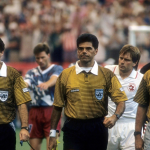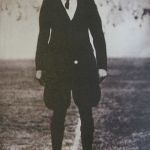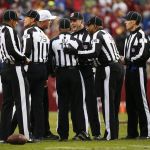
The charm of the uniform in football
Brief history of the referees' apparel in football
January 18th, 2019
In 1581 Richard Mulcaster was writing about a game called ‘foteball’ and suggested that things might go smoother if there was a ‘judge over the parties’. That sport probably had more in common with rugby than the game we know and love today, had perceived the need of the most blamed figure of football, not easily enviable and always recognizable in the field, for gestures and for a uniform that has the duty not to go unnoticed.
The hook to speak about the referees gives us the news of the end of the sponsorship contract between FIGC and Diadora, which will be replaced by Legea starting from the 2019/2020 season. The Italian brand has marked Italian football for 26 years, with uniforms that have followed all phases of the trend and evolution of football design.

In 1893 the FA (Football Association) founded the first umpire organization after a meeting at the Anderton's Hotel in London. The first umpires, however, served in most cases only to keep time, or to have someone to ask for an opinion about the game. At the beginning of the twentieth century, the presence of the referee almost offended the English gentlemen, who knew how to recognize when it was a foul or not, and for this reason, the referees did not play a major role during the games. The history of the design of the shirts of the referees born, however, almost 30 years later in the United States, from practical needs. Not in soccer, but in American football.

In the early days of football, the officials wore white dress shirts, often with a bow tie and usually a beret-type hat, because a well-dressed man was able to transmit greater authority in the field. Problems started to arise in the early 1920s, when the teams adopted white uniforms. In 1920, a quarterback passed a ball to a referee named Lloyd Olds, after mistaking his white shirt for a team uniform. Lloyd Olds, head of the athletics programs at Eastern Michigan University, asked his friend George Moe, owner of a clothes shop, to make him a neutral and more visible uniform that would allow him to arbitrate in several disciplines.
The fans hated it. When Olds first wore the black-and-white-striped shirt in 1921, he “received plenty of boos from the crowd, ” he told an interviewer. And yet the design caught on because it did, in fact, distinguish the ref from the players. The idea then spread quickly and be adopted by other sports, becoming the official shirt of the NFL in 1945, followed in the early 50s by the NBA, who abandoned it in 1971, when they began to wear gray sweaters, even today the official ones.
Meanwhile, in European football, uniforms were composed of a white shirt with a wide collar, a black jacket, Bermuda shorts, and a belt. Only later was adopted a black polo-neck with a white collar, very similar to contemporary models. Gazzetta Dello Sport, on October 17, 1978, on the front page published a short article in which it reported an unusual event at the time.
"The case of the referee Bruno Burgener created a hornet's nest in Switzerland. On Sunday, he directed a Second Division match, wearing a shirt with a conspicuous advertising inscription on his chest and back (adidas ed). The referee said that money has nothing to do with his gesture. The event, which has touched the world of football, is so far to episodes of this type, has provoked the intervention of Swiss federal bodies that have immediately ordered an investigation "
It is easy to imagine that from a few years the alarmed Swiss federal organs, as well as FIFA or the FIGC, began to neglect what became a normal habit, both for the teams and for the arbitral federations. Since 2002, after the World Cup in Korea and Japan, the federations have been allowed to place sponsors on the shirts of the referees. Blatter explained that it was a first step towards the professionalism of the refereeing class.

As for club jerseys, even those of referees have a market of enthusiasts and collectors. It is curious how in some sports such as American football and hockey, uniforms have remained the same, inspiration for fashion designer and salesmen. In football, the chromatic sprint occurred in the mid-90s, with colored uniforms that separated from the traditional black polo. For years the official colors are fluorescent, in Serie A, for example, the most used and with few substantial differences were those in yellow, pink and blue.
We decided to select the 4 most beautiful jerseys, some really untraceable by collectors.
World Cup final, USA '94

Not a great memory for Italy, but the uniforms with pink and black digital pattern marked an important moment for the evolution of the style of the game.
Total black Premier Legue

Essentiality, polo tee that follows the tradition, Premier League lion crest and Nike logo on the chest as the only distinctive elements.
2002 World Cup Qualifier

Fully exploit the effectiveness of the yellow and black color block, adidas slightly oversized sweater, with hidden pockets and cuff, which perfectly describes the style of the 2000s.
Europa Cup final, 1968

Josè Maria Ortiz, the referee of the final between Milan and Hamburg, a class from another era. Black jacket and shirt with shorts.








































.png)


.jpg)



.png)















